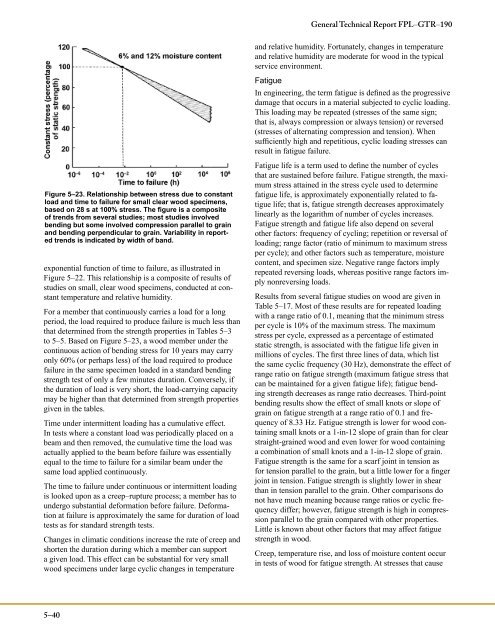Wood Handbook, Chapter 05: Mechanical Properties of Wood
Wood Handbook, Chapter 05: Mechanical Properties of Wood
Wood Handbook, Chapter 05: Mechanical Properties of Wood
Create successful ePaper yourself
Turn your PDF publications into a flip-book with our unique Google optimized e-Paper software.
Figure 5–23. Relationship between stress due to constant<br />
load and time to failure for small clear wood specimens,<br />
based on 28 s at 100% stress. The figure is a composite<br />
<strong>of</strong> trends from several studies; most studies involved<br />
bending but some involved compression parallel to grain<br />
and bending perpendicular to grain. Variability in reported<br />
trends is indicated by width <strong>of</strong> band.<br />
exponential function <strong>of</strong> time to failure, as illustrated in<br />
Figure 5–22. This relationship is a composite <strong>of</strong> results <strong>of</strong><br />
studies on small, clear wood specimens, conducted at constant<br />
temperature and relative humidity.<br />
For a member that continuously carries a load for a long<br />
period, the load required to produce failure is much less than<br />
that determined from the strength properties in Tables 5–3<br />
to 5–5. Based on Figure 5–23, a wood member under the<br />
continuous action <strong>of</strong> bending stress for 10 years may carry<br />
only 60% (or perhaps less) <strong>of</strong> the load required to produce<br />
failure in the same specimen loaded in a standard bending<br />
strength test <strong>of</strong> only a few minutes duration. Conversely, if<br />
the duration <strong>of</strong> load is very short, the load-carrying capacity<br />
may be higher than that determined from strength properties<br />
given in the tables.<br />
Time under intermittent loading has a cumulative effect.<br />
In tests where a constant load was periodically placed on a<br />
beam and then removed, the cumulative time the load was<br />
actually applied to the beam before failure was essentially<br />
equal to the time to failure for a similar beam under the<br />
same load applied continuously.<br />
The time to failure under continuous or intermittent loading<br />
is looked upon as a creep–rupture process; a member has to<br />
undergo substantial deformation before failure. Deformation<br />
at failure is approximately the same for duration <strong>of</strong> load<br />
tests as for standard strength tests.<br />
Changes in climatic conditions increase the rate <strong>of</strong> creep and<br />
shorten the duration during which a member can support<br />
a given load. This effect can be substantial for very small<br />
wood specimens under large cyclic changes in temperature<br />
5–40<br />
and relative humidity. Fortunately, changes in temperature<br />
and relative humidity are moderate for wood in the typical<br />
service environment.<br />
Fatigue<br />
General Technical Report FPL–GTR–190<br />
In engineering, the term fatigue is defined as the progressive<br />
damage that occurs in a material subjected to cyclic loading.<br />
This loading may be repeated (stresses <strong>of</strong> the same sign;<br />
that is, always compression or always tension) or reversed<br />
(stresses <strong>of</strong> alternating compression and tension). When<br />
sufficiently high and repetitious, cyclic loading stresses can<br />
result in fatigue failure.<br />
Fatigue life is a term used to define the number <strong>of</strong> cycles<br />
that are sustained before failure. Fatigue strength, the maximum<br />
stress attained in the stress cycle used to determine<br />
fatigue life, is approximately exponentially related to fatigue<br />
life; that is, fatigue strength decreases approximately<br />
linearly as the logarithm <strong>of</strong> number <strong>of</strong> cycles increases.<br />
Fatigue strength and fatigue life also depend on several<br />
other factors: frequency <strong>of</strong> cycling; repetition or reversal <strong>of</strong><br />
loading; range factor (ratio <strong>of</strong> minimum to maximum stress<br />
per cycle); and other factors such as temperature, moisture<br />
content, and specimen size. Negative range factors imply<br />
repeated reversing loads, whereas positive range factors imply<br />
nonreversing loads.<br />
Results from several fatigue studies on wood are given in<br />
Table 5–17. Most <strong>of</strong> these results are for repeated loading<br />
with a range ratio <strong>of</strong> 0.1, meaning that the minimum stress<br />
per cycle is 10% <strong>of</strong> the maximum stress. The maximum<br />
stress per cycle, expressed as a percentage <strong>of</strong> estimated<br />
static strength, is associated with the fatigue life given in<br />
millions <strong>of</strong> cycles. The first three lines <strong>of</strong> data, which list<br />
the same cyclic frequency (30 Hz), demonstrate the effect <strong>of</strong><br />
range ratio on fatigue strength (maximum fatigue stress that<br />
can be maintained for a given fatigue life); fatigue bending<br />
strength decreases as range ratio decreases. Third-point<br />
bending results show the effect <strong>of</strong> small knots or slope <strong>of</strong><br />
grain on fatigue strength at a range ratio <strong>of</strong> 0.1 and frequency<br />
<strong>of</strong> 8.33 Hz. Fatigue strength is lower for wood containing<br />
small knots or a 1-in-12 slope <strong>of</strong> grain than for clear<br />
straight-grained wood and even lower for wood containing<br />
a combination <strong>of</strong> small knots and a 1-in-12 slope <strong>of</strong> grain.<br />
Fatigue strength is the same for a scarf joint in tension as<br />
for tension parallel to the grain, but a little lower for a finger<br />
joint in tension. Fatigue strength is slightly lower in shear<br />
than in tension parallel to the grain. Other comparisons do<br />
not have much meaning because range ratios or cyclic frequency<br />
differ; however, fatigue strength is high in compression<br />
parallel to the grain compared with other properties.<br />
Little is known about other factors that may affect fatigue<br />
strength in wood.<br />
Creep, temperature rise, and loss <strong>of</strong> moisture content occur<br />
in tests <strong>of</strong> wood for fatigue strength. At stresses that cause

















